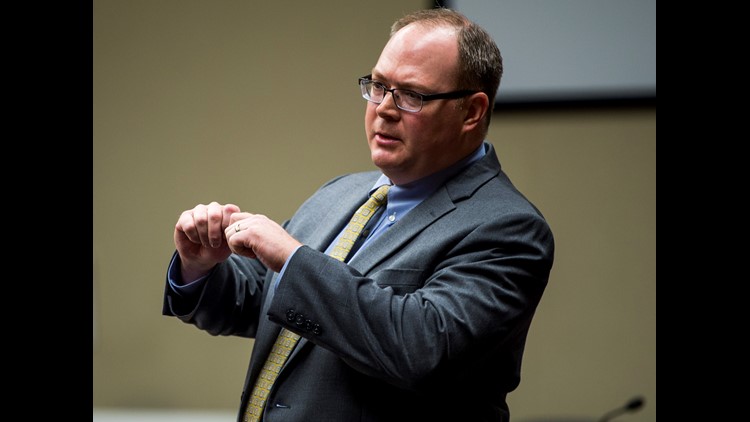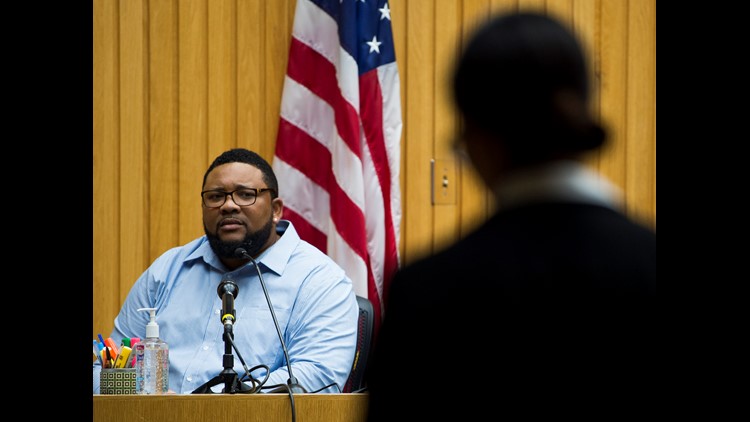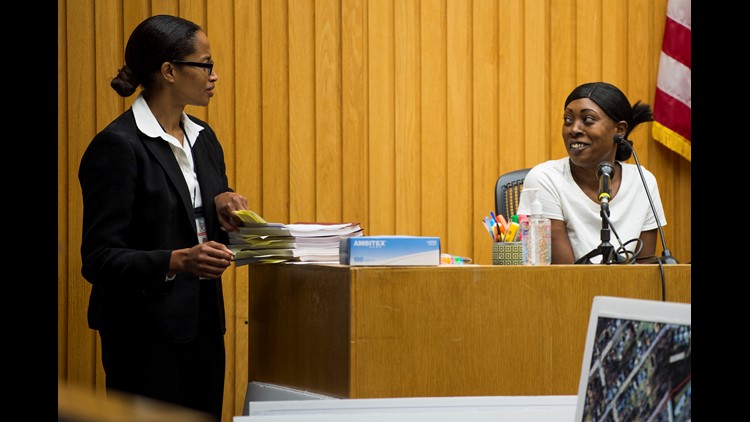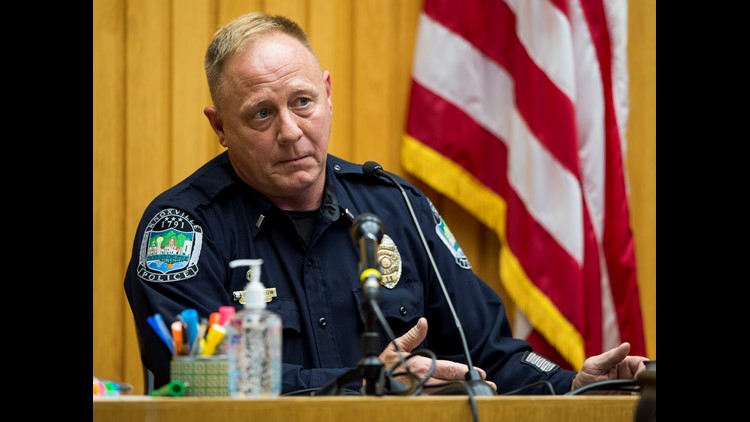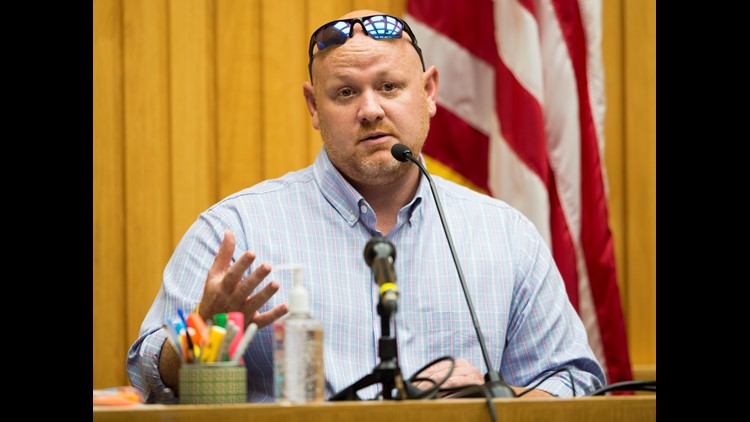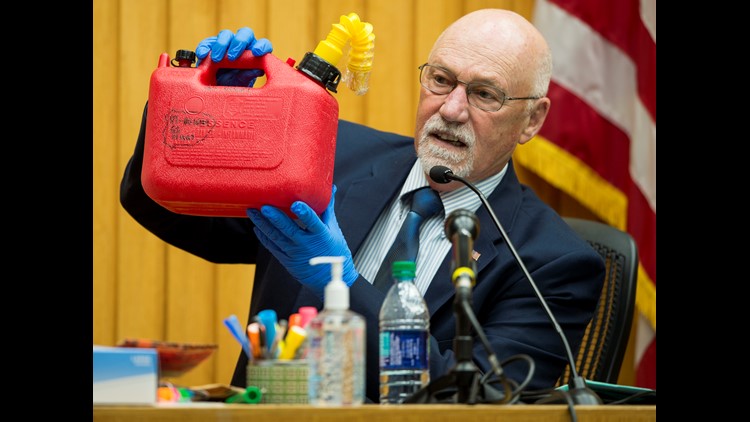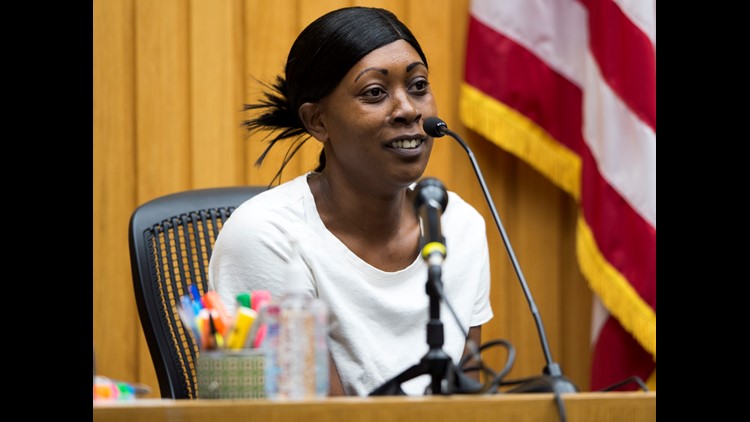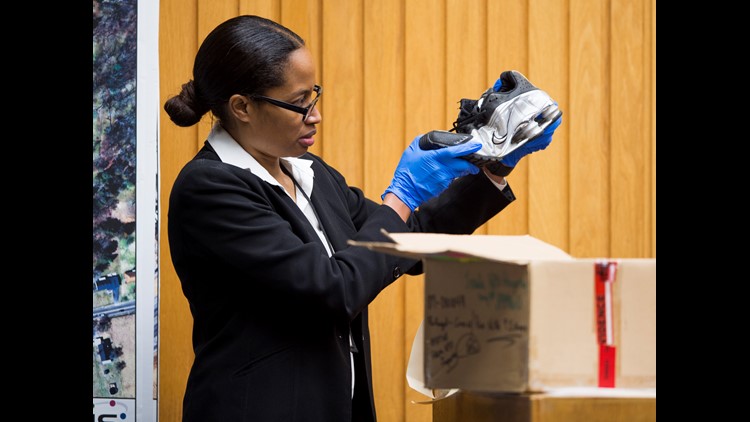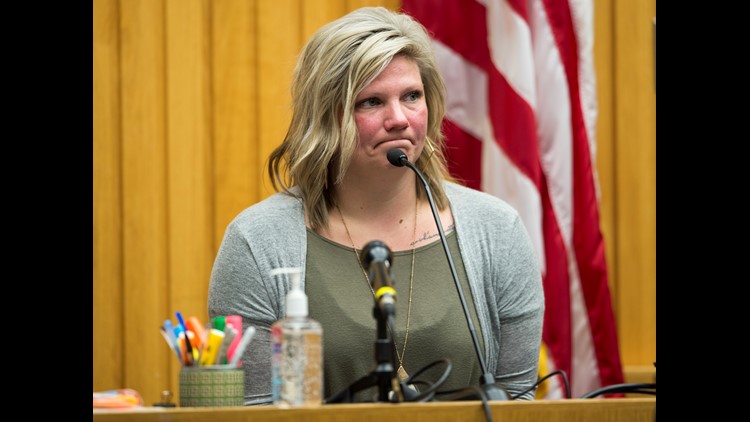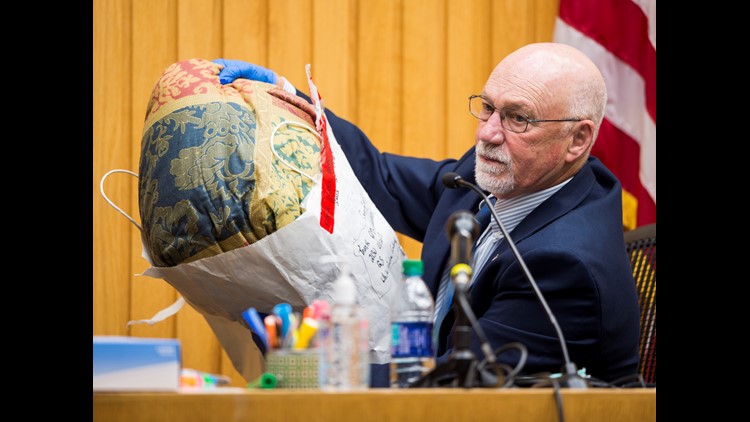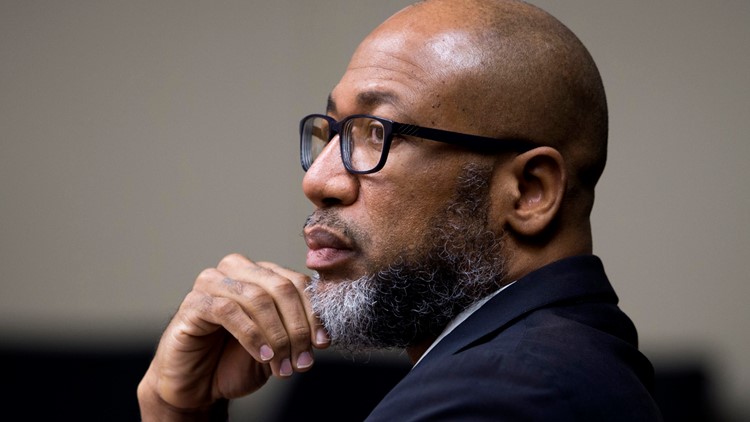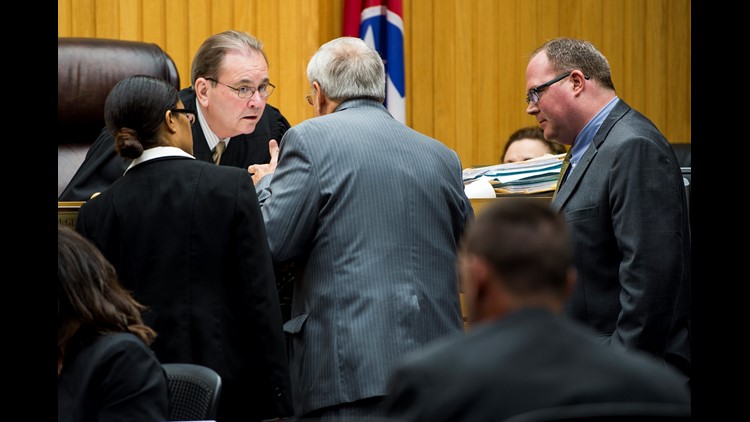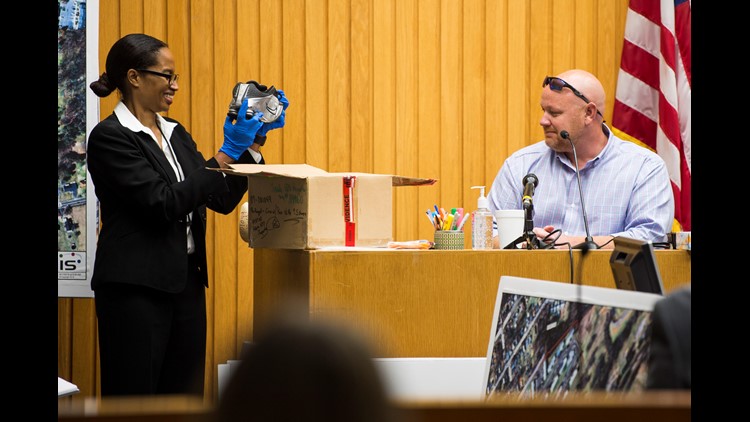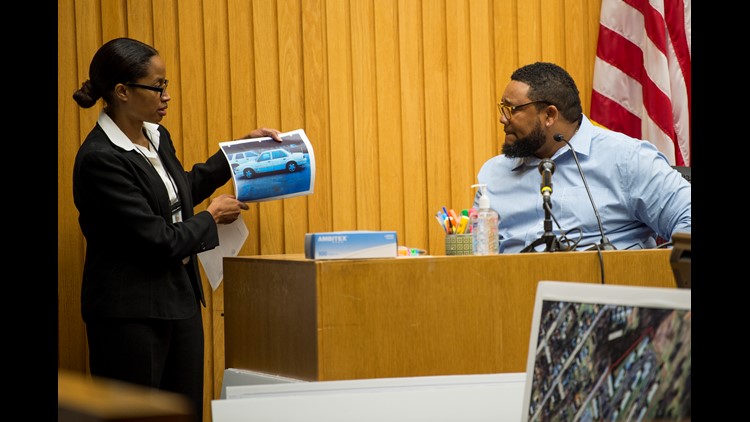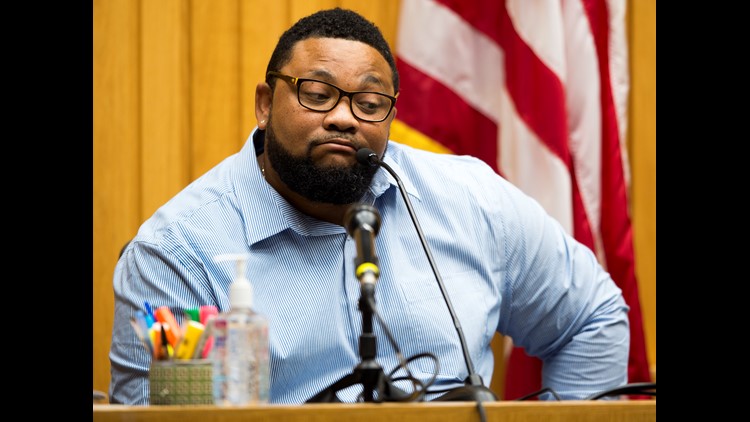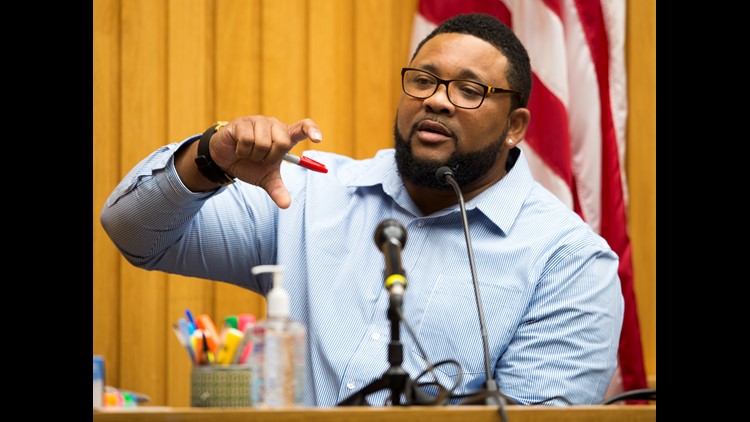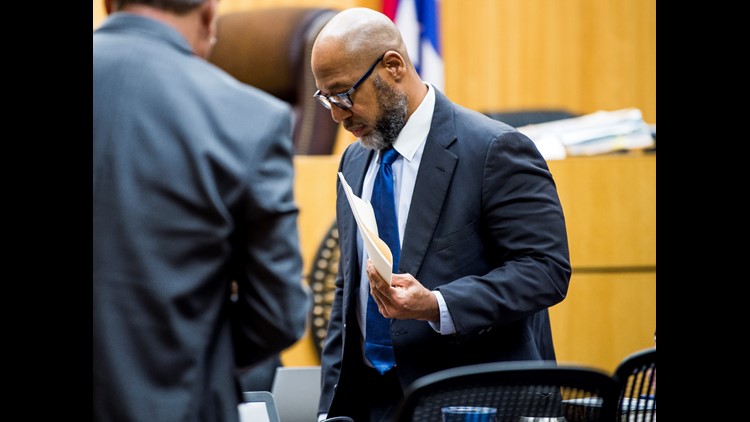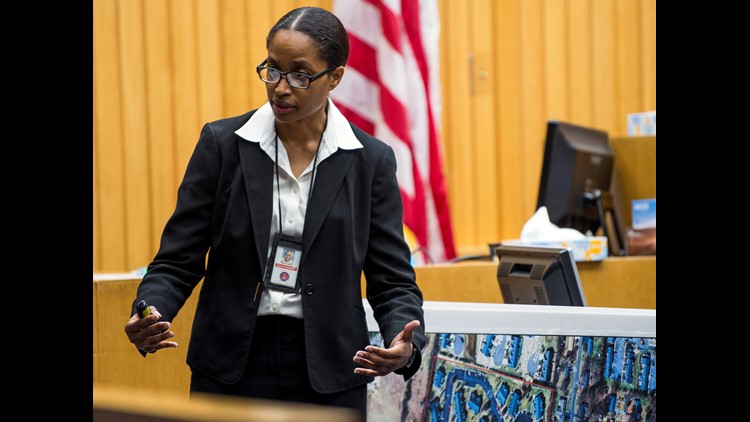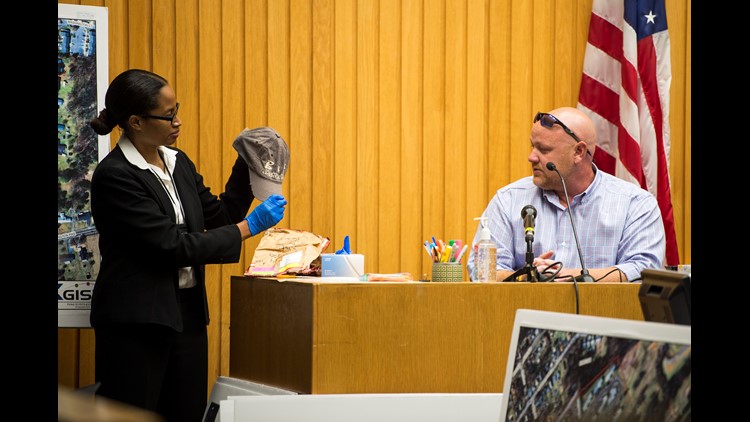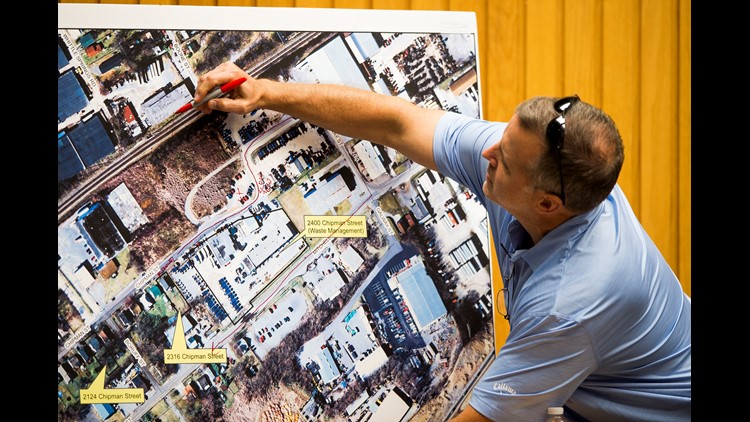KNOXVILLE, Tenn. — Opening statements began Tuesday morning at approximately 9:30 in the trial of Eric Boyd. WBIR is streaming the trial live here.
Boyd faces charges including kidnapping, rape and murder in the 2007 attacks on Chris Newsom, 23, and Channon Christian, 21, in January 2007. You can get full background on the case here.
This story will be updated throughout the day as the trial progresses with the most recent information at the top.
Train engineer J.D. Ford spotted a burned body on the RR tracks
The first day of testimony in Eric Boyd's murder trial ended Tuesday afternoon with testimony about finding the burned body of victim Chris Newsom and processing the car Boyd had been driving.
The trial resumes 9:30 a.m. Wednesday in Knox County Criminal Court before Judge Bob McGee.
Train engineer J.D. Ford spotted Chris's body on railroad tracks near the Chipman Street house the afternoon of Jan. 7, 2007. At first he thought he was looking at a piece of burned wood but as the train got closer he realized what it really was.
The crew stopped the train and called police.
"I saw a severely burned man that didn't have any clothes on," said Ford, who has testified at several previous trials.
When prosecutor TaKisha Fitzgerald showed more close-up photos of Chris's body to confirm that's what Ford saw, there were gasps in the courtroom.
A body found and evidence gathered
KPD Lt. Keith DeBow and retired forensic technician Gerald Smith also testified Tuesday afternoon.
DeBow was among the officers who stormed into the Chipman Street house once police secured a search warrant. No one was inside that Jan. 9, 2007, because the killers by then had all scattered.
Police spotted little that appeared obvious in the cluttered 800-square-foot rental house -- so small it had few doors -- until they got to the kitchen, DeBow said.
That's when they spotted a plastic trash can sitting in the corner. It appeared odd, DeBow recalled. It had an odd bulge.
Advancing with gun drawn, police took off the lid and realized they could see part of Channon Christian's arm amongst all the trash bags in which she was wrapped.
Smith testified that in 2007 he worked gathering and processing evidence for KPD. He photographed and took various items from the house on Reynolds Street off Western Avenue at which Davidson was seized.
Found in the abandoned house were Chris Newsom's new Nikes as well as a .22-caliber revolver, a "flip" cellphone, and a sweatshirt. Prosecutors say Davidson took Newsom's shoes from him during the commission of the homicide
Testing later showed the revolver could have been used twice in the shooting of Chris Newsom. Testing didn't link the revolver to the third bullet recovered from Newsom's body.
Smith also processed the white Pontiac that Boyd's cousin had lent him the night of the carjacking. Inside he said he found a gun holster that had obviously been tucked deep under a seat for hiding.
Boyd's fingerprint later was found on that holster. A convicted felon, Boyd wasn't supposed to own or use firearms.
There also was a gas can found in the trunk. The state alleges Chris's killers used gasoline to set his body on fire early Jan. 7, 2007, after shooting him to death.
Eric Boyd Trial | Day One
Eric Boyd's cousin claims she doesn't remember any of her previous testimony
Adrienne Mathis took the stand after Jenkins. She is the cousin of Eric Boyd and in previous trials, testified that she let Boyd borrow her white Pontiac. She is from Detroit, Michigan and told the State she did not want to be there but was subpoenaed.
The state shows her a few pictures of the white car and she says it looks like her old one but cannot be sure. She says the car was always breaking down, so she kept a gas can "in the back."
Both the State and the defense go back and forth asking her if Mathis remembers letting Boyd borrow the car. She consistently says she cannot remember that far back and adds that she lent it out to everybody.
At one point, the defense asked the jury to leave the room to discuss the Mathis testimony. The defense asked her if when she previously testified she was prepped into just saying what was on paper. She says she doesn’t know if she was prepped falsely but did go with what was said to her said. She says her previous testimonies could have been false.
Mathis says she never picked the car up but saw it a few days later in front of the home of Eric Boyd's mother. She says she does not know how it got there. The State then questions her on finding a "sandwich bag of bullets" in the car. She previously testified to this but said she could not recall it now. In the previously testimony, she said the bullets were small about the size of her pinkie finger.
"She's not denying that she made those statements. she's simply saying that she cannot remember," said the judge and added that she could not be treated as a hostile witness for that reason. According to the Oxford Dictionary, a hostile witness is "a witness who is antagonistic to the party calling them and, being unwilling to tell the truth, may have to be cross-examined by the party." The jury is let back in.
The prosecutor then goes through almost every trial Mathis has testified in to ask her if she remembers any of her testimonies about Boyd borrowing the car or the bag of bullets. She says she can not remember any of it today, even testimony from 2013. The State also asks her to hold up and show her pinkie finger for reference on the bag of bullets. Mathis does not recall anything the defense asked her either.
The defense and the State both reached out to Mathis before this trial, and she ignored both of them, reiterated that she does not want to be there. The State asked her if anyone in her family contacted her about this trial, and she said no. In previous trials, she said she had been contacted and pressured by family, in particular, her brother and Boyd's mother, for not remembering when Boyd borrowed the car. She said she did not recall previously saying that.
Mathis never denied she said any of those things but said she did not remember almost all of it.
Xavier Jenkins saw unusual activity on Chipman Street and explains "mean-mugging"
The first witness after recess was Xavier Jenkins. He was a residential driver for Waste Connections which is located on Chipman Street. At the time of the murders, he was training to be a commercial driver. He says he got to work January 7 at about 12:30 a.m. and parked in a lit gravel lot to wait for his trainer. The Chipman home was catty-corner to where he was parked. He says it could have been as far as a football field away. The house caught his attention because lights were on, and it seemed busy which was unusual for the time of day. He remembers seeing a 4Runner in front of the house with its lights on and a smaller white car parked behind it. The State showed Jenkins a picture of the 4Runner and identified it as the one he saw. He is then shown a picture of the back of the SUV and notices that a power T sticker is not on it like when he first saw it.
Jenkins goes on to say that his trainer was 45 minutes late, so he went inside the building to call him. He then went to a nearby store to get M&M's and a soda. Then, he went back to his car to wait for his trainer. During this time, he says the 4Runner slowly drove by him at about 30 to 40 feet. He saw four people in the car. He says he could not see their features but believed they were black men by their demeanor because Jenkins is also a black man. For about 20 seconds, he says the car slowed down like it was "checking him out." He says the believes the drivers was wearing a bomber jacket with fur trim because he could see the silhouette of it. The passenger was slumped in the seat like he did not want to be seen, according to Jenkins.
After the 4Runner passed him. He said they turned behind the building to turn around. He thought this was suspicious because it was out of their way to do a U-turn. It alarmed him so much he called his father to tell him what was happening.
About 30 minutes after he called his father, Jenkins says his trainer showed up. The two men wait on a couple more people, clock in, and go to work. He says they came back around 6:30 or 6:45 p.m., and the 4Runner is still parked in front of the house. He tells his trainer there is something strange about, so the trainer shines the commercial truck lights at the SUV. They do not see anyone in the car. Jenkins checks the tags to see if the car is from somewhere else, but when he sees the Knox County plate he decides to clock out and go home.
A few days later when the 4Runner is all over the news, he tells his trainer at work around several other people that it is the same "truck" from the other day. Shortly after saying that out loud at work, police interview him, but he did come forward himself. When he was interviewed, the police gave him a car lineup of pictures and asked him to identify the smaller white car. He does and is then asked to initial each photo on the back and right "no" if it is not the car and "yes" if it is. Today, the State has him go through each one and say what he wrote in the back.
The State also asked him about a previous comment he made to officials where he said the people in the 4Runner were "mean mugging" him. He says it is something men do to show their dominance.
The defense asked him how much he read and saw about the case. Jenkins said he has hated the experience and works to not see anything about it. He says he has even unfriended coworkers for posting about the case.
"It's not something I want to remember. I go home to hug my kids as a result of it," said Jenkins. The defense pressed him on the issue, but he was consistent in that he avoids anything about the case.
Jenkins has testified in every trial in connection to the murders of Christian and Newsom. When the defense's investigator tried to get in touch with him for the current trial, he ignored him. Jenkins said that the investigator showed up at his door which made him uncomfortable. The defense asked if the investigator left when asked, and Jenkins said yes.
Kara Sowards was Channon's best friend
Witnesses began to take the stand at approximately 10:38 a.m. The first is Kara Sowards. She was Christian's best friend and the couple was at her apartment the night they were carjacked. She reaffirms much of what the State said in opening statements. She gives her first-person perspective of going back to her apartment to see if Christian and Newsom were still there when the pair did not show up to the party. She also talked about what happened the next day, when she joined Christian's family and Newsom's friends to search for Christian's 4Runner. Sowards identifies Christian's SUV and her belongings that were found in Davidson's home.
Josh Anderson played golf that day with Chris
Next, Josh Anderson, Newsom's friend who he played golf with the day that the pair disappeared, took the stand. He also reaffirms the State's opening statements. He gives his first-person perspective of going to check on Christian and Newsom at Soward's apartment and finding the 4Runner the next day. He identified baseball caps that belonged to Newsom and his sneakers that Davidson stole.
Both witnesses give details on the stickers that were taken off of Christian's 4Runner. They say she had two "Power T"s and an orange North Face sticker on the back on the SUV.
Court took a break for lunch at about noon.
Opening Statements
Prosecution opening statement (9:35 a.m.):
TaKisha Fitzgerald, Assistant District Attorney, started with a set up of how all the suspects ended up together and why they borrowed a white sedan. None of the suspects had a car. She says this is the car they used to carjack Christian and Newsom.
Fitzgerald goes on to describe what Christian and Newsom did before they got carjacked. Christian was at her a friend's apartment getting ready for a party on Saturday, January 6, 2007. Her friend goes ahead to the party around 8:00 p.m., while Christian waits at the apartment for Newsom, who was with a friend. Christian waits over an hour for Newsom. The couple are planning to grab food before the party.
RELATED: Jury seated for Eric Boyd trial
At this point, Fitzgerald is naming many people which could seem confusing to jurors.
Fitzgerald states that at around 10:00 p.m. that night the couple's friends at the party started to wonder where they were. They called and texted both of them several times with no response. Some friends eventually decided to go back to the friend's apartment to see if they were still there. They find Newsom's truck but Christian's 4Runner is gone. At around 3:00 a.m., the truck is still there with no sign on Christian's SUV. Christian's friend is worried, but Newsom's friends just assume the couple did not want to go to the party and are hanging out somewhere else.
The State now goes into what happened to Christian and Newsom. Fitzgerald brings in Xavier Jenkins who worked for Waste Management right next to Chipman Street. The State says that according to Jenkins, the state says Chipman Street is "busy" with a 4Runner outside and a white car parked behind it and a light on. At approximately 12:30 a.m. that same night, Christian calls her father to tell him she is at her friend's house and will be back home tomorrow. According to the State, this is the last time anyone hears from Christian.
RELATED: The last suspect | 'I’ve always had a mother’s instinct that he was the one who murdered my son'
RELATED: 12 years later, the final suspect in the Christian-Newsom torture-slayings is set for trial
Fitzgerald says Jenkins drove by the 4Runner on Chipman Street again and saw four black men in the SUV. It seemed strange to him because they all gave him a weird look.
At approximately 1:45 a.m., a neighbor and witness who the state refers to as Mr. Arnold hears "pop, pop, pop." At the time, he just assumes it is some kids playing with fireworks. The State believes these are the shots that killed Newsom.
In the morning at about 7:45, a witness sees smoke coming from some railroad tracks near Cherry Street.
That afternoon at approximately 12:15 p.m., no one has heard from Christian or Newsom. A witness goes to the home on Chipman Street to get money from Lemaricus Davidson who rented the home. She sees George Thomas, who is set to testify against Boyd, near the home. She does not like him, so she turns around and leaves. She gets stuck behind a train on Cherry Street. That train is believed to be operated by witness Mr. Ford who sees something near the tracks that looks like a log. As the train gets closer, he realizes it's a person. The body is burned and his wrists and ankles were bound with a cloth tied around his head and neck. The autopsy that identifies the body as Newsom is done the next morning on January 8. He is shot in the shoulder, neck and head. He was barefoot.
Sunday afternoon shortly after Newsom's body was found, the State says Christian's friends and family speak to retired detective Jack Barnes. Her family had U.S. Cellular check the last known location of her cell phone. The last place her phone pings is Cherry Street at 12:33 a.m. early Sunday morning. Barnes tells them to go to Cherry Street and look around. They eventually find the 4Runner. It is empty, muddy, and the seats were moved back. All of this is unusual for Christian. Several stickers on her car had been taken off. They have the SUV towed.
The police get a search warrant to search Davidson's home on Chipman. No one is home but they find Christian's body in a trashcan. She was placed in trash bags while she was still alive and suffocated, according to the autopsy. Many of her belongings that were in Christian's 4Runner were found in the home. Police also found shell cases and gas cans. Both autopsies indicate both Newsom and Christian were raped.
Police brought in Daphne Sutton, Davidson's ex-girlfriend, for questioning because they could not find Davidson. The State says she left the house on Friday but went back Sunday because Davidson wanted to give her some clothes. George Thomas and Letalvis Cobbins were there. Sutton had to go to the bathroom but the door was locked. Davidson wouldn't let her in. Later, she realized they were used and did not want them anymore. She did not know the clothes were Christian's or that Christian's body was in the house while she was there.
Davidson then tells Sutton to take him to E, which is what he called Eric Boyd. Police then interview Coleman, Cobbins and Thomas. On January 11, Thomas identifies Boyd, Davidson and Cobbins. This is not enough for law enforcement because Cobbins will not talk. Boyd knows about a vacant house in Knoxville and helps Davidson to hide in it. Law enforcement finds Boyd, and he tells them where Davidson is. He is released after they have Davidson. He is found wearing Newsom's shoes. They then take Boyd in again as an accessory.
Police search the white car Boyd borrowed and find gas can in the car. The owner says she ran out of gas in December, so it was in there when she let Boyd borrow the car. Christian and Newsom's DNA is also found in the car.
Fitzgerald ends her opening statement by saying George Thomas will testify for a lesser sentence.
Defense opening statement (10:26 a.m.):
Clinton Frazier, Boyd’s defense attorney, is much briefer than Fitzgerald. He says the community has every right to be angry with what happened to Christian and Newsom. He adds there is plenty of DNA evidence in the case, but that there is no DNA evidence of Boyd that places him at the crime scene.
He also takes issue with the fact that the prosecution's case seems to rest on the testimony of George Thomas, who was convicted in the murders more than a decade ago. Thomas has agreed to testify against Boyd in exchange for a reduction in his sentence.



